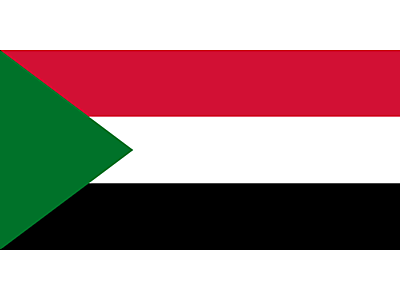Interesting Facts About Sudan
Posted by khethiwe qotyana on 10 April 2018, 14:30 SAST

Sudan used to be the largest country in Africa and the Middle East (area wise), before the country split in two in July 2011 (Sudan and South Sudan). In addition, it ranked as the 10th largest country in the world. Today, Sudan is third largest country in Africa (after Algeria and Democratic Republic of the Congo) and the 16th largest country in the world. It covers an area of 728,215 square miles and has an estimated population of 30,894,000.
- Since the country’s independence in January 1, 1956, six individuals (and three multi-member sovereignty councils) have served as head of state of Sudan, currently under the title President of the Republic of Sudan.
- The country’s name derives from the Arabic bilad al-sudan, which means “land of the blacks.”
- The capital of Sudan, Khartoum, means elephant trunk in Arabic, which refers to the large bend in the Nile River that it makes as it flows north from the city.
- The White and Blue Nile rivers run through Sudan and merge at Khartoum, becoming the Nile River before flowing into Egypt.
- Although much of Sudan’s land is made up of plains and deserts, it has large areas of arable land, significant gold deposits and massive oil reserves.
- Thousands of years ago, the area of north Sudan was extremely volcanic, remnants of these old volcanoes can be seen in the north.
- Oil accounts for about 73% of Sudan’s total export revenues. Officials from the Sudanese Energy Ministry estimate that the county has 3 billion barrels of oil reserves.
- There are a large number of old Egyptian ruins and pyramids in Sudan, even larger in number than the ones in Egypt (although not as old), as the country was once part of the Egyptian realm, prior its independence. Read more about this on The New York Times.
- Sudan had one of the first and most active women’s movements in the African and Arab world during the 1960s–70s. In addition, Sudanese women are also pioneers in science, politics and activism. Sudan boasts the first female parliamentarian in Africa and the Middle East (1965), the first female Minister of Health (1974); and the Middle East’s first female judge, cinematographer, football referee, army and police officers.
- Sudan is the first Muslim and Arab country to appoint a female as a judge. This took place in the 1960s. There are at least 67 judges in the Sudanese judiciary today, which is more than any other Arab or Muslim country in the world.
- Before the Arab Spring, which begin in Tunisia in 2010, Sudan was the first country to carry an uprising – not only once but twice. The first took place in 1964: the so-called ‘October revolution’ ousted Sudan’s first military dictator, General Aboud. The second occurred in 1985 and toppled another military dictator, Jafar Numeiri, who had come to power in a coup in 1969.
- In July 2008, the International Criminal Court’s (ICC) top prosecutor called for the arrest of President Omar Al Bashir for genocide, crimes against humanity and war crimes in Darfur; the appeal is the first ever request to the ICC for the arrest of a sitting head of state. Sudan rejects the indictment.
- The literacy rate of Sudan is 62% – 70%, according to a UNESCO study and other reports.
- Only about 68% of children are enrolled in primary school; this number drops once children enter secondary school. (More number of girls die during childbirth or pregnancy than when trying to complete their primary school).
- Sudan has a youth unemployment rate of 34%. More than 18% of Sudan’s population is unemployed and about 40% (37 million) of the population lives below the poverty line.
- According to the CIA – The World Factbook, only 3.3% of Sudan’s population is 65 years old and above, and only 3.8% are between the age of 55 and 64. The life expectancy in Sudan is 61 years.
- Although the official languages spoken in the country are Arabic and English, anthropologists and social scientists have identified more than 100 languages and dialects that are used in Sudan. The Afro-Arab ethnic and linguistic diversity remains one of the most complex in the world. Nearly 600 ethnic groups speak more than 400 languages and dialects, many of them intelligible to only a small number of individuals. Today, sources identify the minimum number of individual languages listed for Sudan as 78. Of these, 75 are living and three are extinct. Of the living languages, nine are institutional, 10 are developing, 22 are vigorous, 17 are in trouble, and 17 are dying.
- About 400 BC, the ox-driven water wheel was introduced to the Sudan. It still plays a vital role in the country’s economy.
- The natural resources include copper, chromium ore, petroleum, zinc, small reserves of iron ore, hydropower and mica, tungsten, silver and gold. Agricultural production – such as cotton and peanuts cultivation – employs 80% of the workforce and contributes 39% of the gross domestic product.
- Sudan is the world’s largest producer of gum Arabic. It exports 70% of the world’s gum arabic from just 20% os its available trees. Learn more on CNN!
- Sudan currently ranks 3rd on the list of African gold producing countries.
- According to the United Nations (UN), civil war in Darfur region is seen as “one of the worst nightmares in recent history.” Furthermore, “the Sudan crisis is the most dramatic race against the clock anywhere in the world at the moment,” stated the UN.
- Despite being a refugee-generating country (an estimated 200,000 Sudanese from Darfur have escaped to Chad, where they are living in refugee camps), Sudan also hosts a refugee population. According to the World Refugee Survey 2008, published by the US Committee for Refugees and Immigrants, 310,500 refugees and asylum seekers lived in Sudan in 2007. The majority of this population came from Eritrea (240,400 persons), Chad (45,000), Ethiopia (49,300) and the Central African Republic (2,500). In 2007, the Sudanese government forcibly deported at least 1,500 refugees and asylum seekers during the year. Sudan is a party to the 1951 Convention Relating to the Status of Refugees.
- According to Sudanese law, the minimum age for a male to get married is 18 and above, while a female must be 16 years old or above.
https://oladiab.com/2013/04/19/interesting-facts-about-sudan/
